All In Hand – Lessons In Hand Quilting
Hello Dear Friends and Readers, although I do love machine quilting, I am all about efficiency too. Whilst that may seem like an extreme contradiction, when it comes to hand quilting, I will explain my thoughts on why this idea could be challenged.
Before beginning, I would like to say that I am not an expert in hand quilting and my experience is limited. This is only the third quilt which I have hand quilted but by far the biggest. The look of hand quilting is unique and quite different to machine quilting. I do think it evokes a more traditional and romantic feel both in touch and appearance.
My interest in writing this post was peaked recently when I read a comment from a lady who was hand quilting a family quilt, that she only quilted it at times when she could make “perfect stitches”. I thought about that and it struck me that if one never practiced then how could one make perfect stitches? I had already commenced hand quilting this quilt a couple of months ago and I am glad that I decided to take the challenge. I thought, the only way to get better at it is by ”giving it a go”. After all, we are not talking sheep stations here. It’s a quilt.
Furthermore, finished is better than perfect. My stitches are not perfect, however, I think there is some improvement. I am able to get more stitches to the inch and that probably counts. I have 687 hexies to quilt, so that should be some good practice.
I decided to quilt this of an evening when I might be sitting down and relaxing. I calculated that if I did several hexies each day, it might be done in six months. I think that actually isn’t too bad considering I may have just been watching TV or relaxing. So there is the thing….it creates an efficiency from that time which I would have been sitting down anyway. I have discussed a similar thing about hand piecing previously in While We Wait
I do believe there are two tricks to this idea. The first is making the decision to do it. I think sometimes more time is wasted procrastinating about how to do it, than it actually takes to do it. Its easy to overthink it. The second is organising the project. When something is cut out and ready to piece it is easy to pick it up and go anytime. Same for the hand quilting. If the top is prepared with backing and batting and basted or pinned then it is much easier to do a little at more regular intervals.
In this instance because this top was hand pieced, I wanted to hand quilt it. Grandmother’s Flower Garden Quilt Like Grandma Used to Make
Anyhow these are the lessons I have learned so far.
Lessons In Preparation For Hand Quilting
Rightly or wrongly, I decided to baste the quilt with safety pins. Actually it was quite funny, when I was trying to buy lots of pins, the lady seemed not to want to sell them to me, she said you can only quilt one quilt at a time. I found myself explaining that I wanted to do more than one quilt, some machine quilting and some hand quilting so eventually I purchased a big bag of them.
I put plenty of pins into the top which was good is some respects as it is easy to remove them at each spot and then readjust the smoothing of the backing fabric if necessary.
Also, I bought some bulldog type clips, which I used to fold the backing edges to the front of the quilt to keep it organised and protect the edges of the quilt, until it is completed.
I left the papers in the hexies all around the perimeter to give it stability until I get to the edges.
I am using a quilting hoop which I bought second hand at a quilting market. I bought some Gutterman Hand Quilting thread. I bought this thread because there was actually not many to choose from due to supply chain issues from Covid. I chose a linen colour to give it a bit of depth and dimensionality.
Reviewing The Hand Piecing
Even though I believed my hand piecing to be okay for the English Paper Piecing and I did do locking stitches very regularly for every seam, I was disappointed that some of the seams were a bit weak when I put the quilt into the hoop for quilting, not all the time, but occasionally this has been exposed. I will be more careful next time. I used a polyester thread for the hand piecing, maybe that was not a good idea….I was using up thread I already had.
Requirements For Hand Quilting
One quilting hoop
Small scissors
Lots of basting pins (200+)
3 x spools of waxed hand quilting thread 50wt
Quilting needles – I chose the larger ones as I am not an accomplished hand quilter
A small bag to hold these tools. I am using this beautiful handpieced bag which was sent to me by my friend Ellie M. It’s just perfect for this use. See the photo below. Thank you Ellie!
Quilting Thimble – I am using one from the Thimblelady
Optional fingercot for the opposing hand
Optional Headlight for night time or low light situations
A Simple Hand Quilting Design
Keeping with a traditional design and in keeping with my original idea of making a Grandmother’s Flower Garden Quilt Like Grandma Used To Make, I decided just to quilt each hexagon approximately 1/4” away from each seam edge. I did not mark the quilt. I have just done it freehand. I started from somewhere near the centre of the quilt and I am gradually working my way outwards.
Threading The Quilting Needle
I decided, rightly or wrongly to use a double thread. to do this quilting. So in other words, tanking a length of thread, threading it and then put the two ends of the thread together and make a knot. I like the look of the thread being a bit thicker and once the needle is threaded it doesn’t fall off. The length is probably personal taste. Not too long or it becomes unwieldy and not too short as it is more knots and interruption. I found a length of about 3 feet then doubled and knotted to be about 18” long to be about right. I gather some people thread up a whole lot of seperate needles and have them prepared. I haven’t done that as I found that the thread can easily get tangled, so I just did one at a time as I have used it.
Using The Hoop
Starting at or near the centre of the quilt, I applied the hoop. I found that it takes a bit of practice to get it sitting nicely. I tried not to make it super tight as this does put unnecessary tension on the stitching lines where the hexies are joined. I found that I could centre about three of the hexies at a time which made it easier to quilt. It is harder to manipulate the needle near the edges of the hoop. I did not overtighten the top hoop screw as it makes it harder to get on and off each time and I did not want to put unnecessary tension on the seams.
Burying The Knots
One of the techniques which one needs to develop with hand quilting is burying the knots. I have done this by inserting the needle approximately 3/4 to 1” away from the start point. Then pulling the thread through until the knot ”pops” through the fabric and is buried into the quilt top, then the quilting stitches can begin. To end, the same procedure applies. When I have a bit more than the length of the needle of thread left, I knot the thread right near the quilt, and then take the next stitch into the fabric and have the needle exit about 3/4” away and then pull until the knot pops through the top of the fabric and is buried into the top of the quilt. Then, keeping a bit of tension on the thread, I cut the thread carefully near the quilt so that the end disappears inside the quilt.
Wearing The Thimble
The thimble is a matter of personal preference. I think that everyone needs to find the thimble that suits them. I tried a few before I found one that I like. Thimbles have indentations or dimples on them. They can be all over, or on the top or sides. These dimples are known as knurlings and they stop the needle from slipping. Here is an interesting article about thimbles.
The one I am using is from Thimblelady. I settled on this one for the moment. I found I was able to more easily push the needle through the thicknesses with this particular thimble. This one has a bank of knurlings on one side.
Making The Quilting Stitches
With the needle threaded, the hoop applied and the thimble on, It is time to decide whether or not you also wish to use s finger cot or leather finger protector for the finger on the opposite hand which will be under the hoop. This is because the finger underneath will be used to ”feel” the needle emerging through the quilt. this opposing finger will develop a bit of a calous over time a finger protecter is not used. This is personal taste. I am not using one as I like th feel the tip of the needle coming through and it is easier to judge repositioning the needle t make the stitch.
Push the needle vertically into the quilt after burying the knot. With the opposing hand underneath, feel the tip of the needlecome through the quilt. It should be just through. now lay the needle down flat, and push the needle a short distance back through the quiltusing the thumb to depress the quilt at the same time to allow the needle to come through. accomplished quilters can make a few or several stitches like this with one pass of the needle. This action is known as rocking the needle. My limit is one to two stitches. That is okay as I am still leaning. Make sure that the threads are pulled through evenly top and bottom. that is the advantage of having the opposing hand underneath to feel that there is no free length of thread left behind.
Note to self: make sure the papers are removed before quilting. I realised afterwards that I have left a couple of papers in without even realising when I quilted those hexies. Maybe it was late…. It wasn’t hard to do. Just something to keep in mind! 😂 They will stay there now forever.
Still a way to go but overall a very enjoyable activity. I have taken it on holidays which has turned out to be a godsend as it has been cold. …thank goodness for quilts . 💖
If you have enjoyed this post, you may also like
Orange Peel Quilt Blocks Pattern
Periwinkle Blues Quilt – Part 2
Happy Stitchhing
Susie
© Susan Stuklis 2022

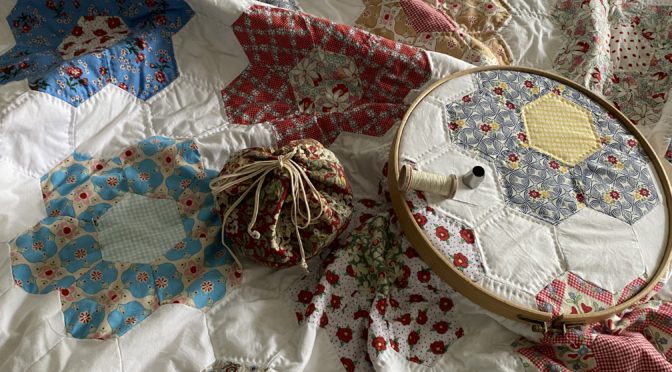
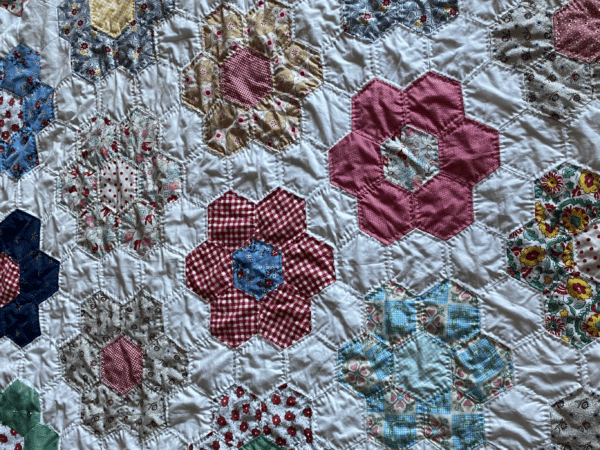
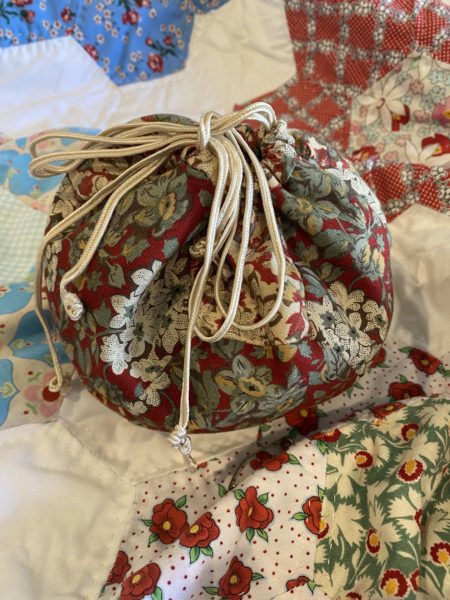
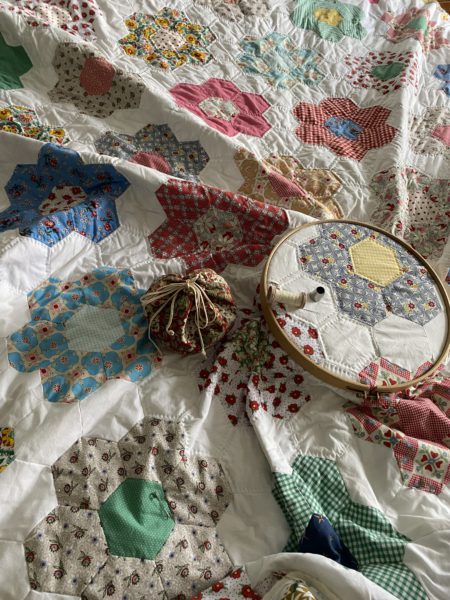
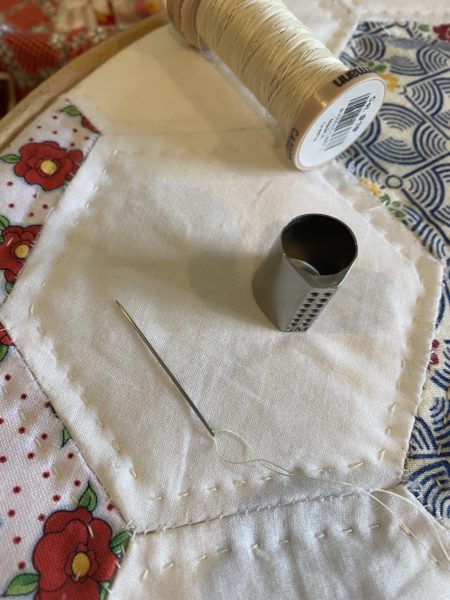
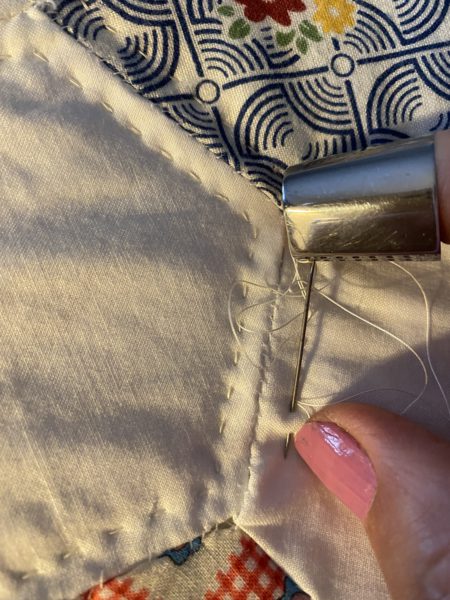

I have embarked on a hand Hexie flower garden quilt but have replaced the papers with batting … the result is super soft.
I intend to hand quilt the flowers as in your very detailed tutorial. I have joined all the flowers together but still unsure how to achieve a straight border without cutting and squaring up. Hoping there is a simple solution out there for me
I have loved the challenge of hand sewing at night while watching television. It also gives my time during the day for my machine quilting . I am already planning the next one!!
Hi Jeni,
Hopefully this post can help you to decide how to finish your quilt.
https://susies-scraps.com/2022/10/07/bias-binding-for-hexagon-quilt/
Using the batting is a great idea!
Great tutorial, Thank you!! I have everything ready to go & procrastinating as this will be my first time hand quilting on my first completed quilt. This tutorial has now given me the confidence to make a start on it, coming into winter in Australia it will be great to keep warm whilst keeping my hands & mind busy.
Thank you again Susie
Hi Meghan, I am delighted! You will love cozying up under your quilt whist you quilt it. Such a lovely thing to do in the winter. Best wishes, Susie
Do you have any suggestions on the quilt hoop? Size? Where is best to purchase? I see lots of embroidery hoops, but it looks like quilt ones are a bit heavier-duty.
Hi Jean, thank you for asking. I bought a couple second hand from other quilters at fabric/quilt fairs. Good quilt shops should have them. I looked on line. Etsy have them in stock. Hope that’s helpful.
Great tutorial
I want to learn new skills and have something to do since I am on maternity leave. I decided to learn Amish Handstitched quilts. It’s good that a company supplies this material here in St. Joseph, MO.
Your quilt is charming!
I decided to hand-quilt for the first time when I made a quilt for my daughter going away to college/university — it needed to be *even more* special, if you know what I mean. I also realized how much softer (as it were) the resulting stitches are than an interlocked machine seam. It was pretty clear to me that I’m not very good at hand-quilting — yet == but you are absolutely right, how can you get better if you don’t practice?!
There is an amazing amount of time in the evenings, watching television, that I find invaluable for needlework. “No idle hands”!
Your quilt stitches look very nice. I always tell a beginning quilt that the important thing is to have the stitch length be even. Shorter stitches come with practice. Hand quilting has a different texture than machine quilting. Happy stitching!
Dear Susies-Scraps, I am the “entusiasta” too of the quilting by hand, and congratulations for you great idea “sobre el tema”… I do not speack english, but I know the “sentido general de tu artículo”… “Recibo” your newsletter by e-mail, “por este motivo te pregunto ¿Por qué no instalas” in your blog the google translation for the friends…? I am from Barcelona… “En mi época escolar estudiábamos” french language, ” y me gustaría poder leerte mejor”… Thank you so much and sorry, Joana
Estimada Juana,
Muchas gracias por su considerado correo electrónico. Estoy tan encantada de que disfrutes de mi blog. Acolchar a mano es un placer.
Al usar Google Chrome para abrir mi página, verá un pequeño ícono en la barra de direcciones en el lado izquierdo. si toca/hace clic en eso, aparecerá un cuadro de aviso que le preguntará si desea traducir. Al usarlo, podrá traducir cualquier artículo extranjero que abra. Espero que esto sea un éxito para ti.
Gracias una vez más y los mejores deseos,
susie